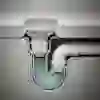Step-by-Step Troubleshooting Flow For Shower Drain Problems
1. Run the Water: Pour a gallon of water down the drain. Did the smell stop?
YES: The problem was a Dry P-trap. Regular maintenance (monthly running water) is required.
NO: Proceed to Step 2.
2. Check the Temperature: Run hot water for 30 seconds, then cold water for 30 seconds. Does the smell only happen with hot water?
YES: The problem is the Water Heater Anode Rod. Call a professional plumber or technician.
NO: Proceed to Step 3.
3. Deep Clean: Use a drain snake to physically remove the hair clog, then immediately follow up with a baking soda and vinegar flush. Did the smell stop permanently?
YES: The problem was biofilm and bacterial buildup. Repeat the natural cleaning monthly.
NO: Proceed to Step 4.
4. Call the Pro: If the constant smell persists after cleaning and refilling the trap, the problem could be a Vent Pipe Blockage or a broken sewer line that's releasing gas. This requires professional diagnosis and repair.

